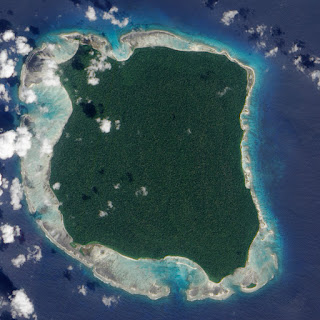North Sentinel Island is a green speck in the Bay of Bengal, some 1,200 km from India, and 500 km from Myanmar. It is one of the 184 islands in the Andaman and Nicobar archipelago, governed by India, and one of the 30 or so inhabited islands in that chain. But it is the one that has resisted most strongly any attempts to make contact or impose "civilization".
 |
| North Sentinel Island (Wikipedia) |
North Sentinel Island is inhabited by anywhere from 50 to 500 indigenous people (no-one really knows how many), who speak their own language, known unsurprisingly as Sentinelese. They live a hunter-gatherer lifestyle, spear-fishing from dug-out canoes and living in rudimentary huts, essentially unchanged since Neolithic times, and they wear no clothes.
The Andaman and Nicobar Islands have been known to European traders since the 1770s but, unlike some of the other Andaman Islands, they have always met any attempt at trade, missionary work or anthropological research with a volley of arrows. Even fishermen accidentally stranded on the island have met with an untimely death, as did an American missionary who visited the island in 2018 (despite a well-publicized ban on visits to the island for any purpose, which has been in force since 1996).
The island currently enjoys a "hands-off, eyes-off" status internationally, so that it is protected from the four Ts: travel, tours, transport and trade.
No comments:
Post a Comment